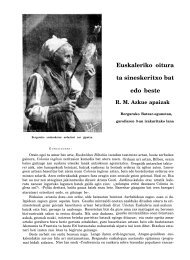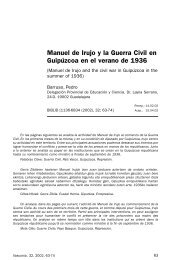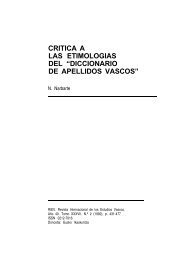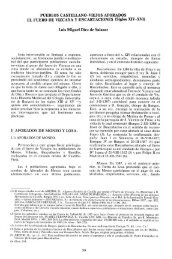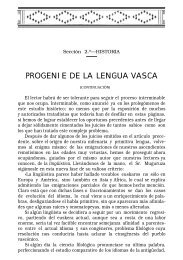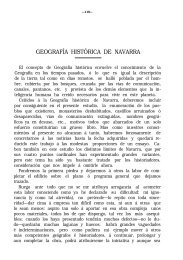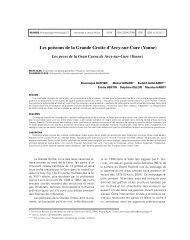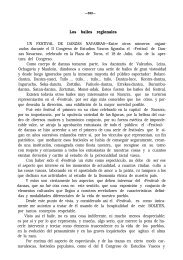Early bilingualism and word order in Breton. IN: Kode bereizketa eta ...
Early bilingualism and word order in Breton. IN: Kode bereizketa eta ...
Early bilingualism and word order in Breton. IN: Kode bereizketa eta ...
You also want an ePaper? Increase the reach of your titles
YUMPU automatically turns print PDFs into web optimized ePapers that Google loves.
F a v e reau, Francisthe norm, as opposed to the colloquial use of XVY after p e o g w i r <strong>in</strong> a para-syntactic manner(p e o g w i r be<strong>in</strong>g then considered as p’eo gwir - s<strong>in</strong>ce or as it is - Hewitt 1985).The other stru c t u res, which have been labelled as emphatic <strong>and</strong> are more rarely used,appear a number of times. Examples 133 <strong>and</strong> 139 illustrate the periphrastic conjugation (139:klask a ran...). On the other h<strong>and</strong>, use of the direct complement first <strong>in</strong> a topicalized position(that has permeated through local French (4, 5, 6) is evidenced <strong>in</strong> 136 (tokoù ‘mo).Negative sentences have also been produced (137), without us<strong>in</strong>g the personal pro n o u nm e, which would have stressed the subject of the action.T h ree faulty sentences have been listed at the end of the childre n ’s corpus (148, 149,150). Only one (150) is pla<strong>in</strong>ly <strong>in</strong>correct <strong>and</strong> will be analysed <strong>in</strong> some length, all the more soas it not <strong>in</strong>frequent <strong>in</strong> the case of learners <strong>and</strong> bil<strong>in</strong>gual school-children <strong>in</strong> part i c u l a r, while itrema<strong>in</strong>s def<strong>in</strong>itely shock<strong>in</strong>g to any <strong>Breton</strong> speaker, except maybe <strong>in</strong> the v a n n e t a i s a rea, whereit can be heard of late, because of a confusion between the first consonant of ‘m eus ( t h a tis M) <strong>and</strong> the contracted form of the personal pronoun m’ < me (only ‘m eus aon = I’m afraid,mean<strong>in</strong>g I suppose, I hope... is acceptable <strong>and</strong> even very much used <strong>in</strong>deed). This error canalso be expla<strong>in</strong>ed by the abnormal status of “to have”, which is no verb <strong>in</strong> <strong>Breton</strong>, but a verballocution or phrase: ‘m eus simply st<strong>and</strong>s for “belongs to me” (as <strong>in</strong> Middle Welsh Am bof o rd d ! = Let me have a way!), <strong>and</strong> the object pronoun ‘ m happens to sound just like the apocopeof the subject pronoun ‘ m !But 149 (E oa e-giz-se), though break<strong>in</strong>g the rules that have been edicted, is acceptable,for this apparently non-grammatical stru c t u re is very common <strong>in</strong>deed <strong>in</strong> colloquial speech:this SVO stru c t u re is quite frequent <strong>in</strong> most dialects with verbs such as bezañ, mont, dont,e t c . . . But such a use of VSO must be felt as idiomatic <strong>and</strong> pert<strong>in</strong>ent, <strong>and</strong> 148 sounds muchless probable or even acceptable than E-giz-se ‘oa <strong>in</strong> adult speech.3. CONCLUSIONSWhat can be stated <strong>in</strong> conclusion is that almost the whole range of syntactic patterns thatadult <strong>Breton</strong>-speakers will use can be found, more or less, <strong>in</strong> this corpus of child speech, limitedas it is. Even the pro p o rtion of emphatic <strong>and</strong> non-emphatic (or neutral) stru c t u res seemsto be found <strong>in</strong> our sample, <strong>in</strong> the mouth of the older children at least. For the <strong>in</strong>fluence ofF rench syntactic stru c t u res, so very diff e rent from the <strong>Breton</strong> ones (that is French SVO / <strong>Breton</strong>XVSY), is stronger at the beg<strong>in</strong>n<strong>in</strong>g of the school<strong>in</strong>g period through immersion (from theage of two) than later by the age of six, for they tend to dim<strong>in</strong>ish as the children acquire richers t ru c t u res from both school <strong>and</strong> environment, hopefully.1 2 0 Ikastaria. 12, 2000, 107-122




